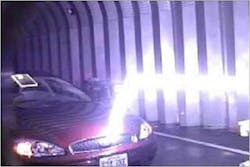New laser weapon shoots lightning bolts down laser beams
Picatinny Arsenal, NJ--Picatinny Arsenal scientists and engineers are developing a new laser weapon that will shoot lightning bolts down laser beams to destroy its target. The Laser-Induced Plasma Channel, or LIPC, is designed to take out targets that conduct electricity better than the air or ground that surrounds them. "We never got tired of the lightning bolts zapping our simulated (targets)," said George Fischer, lead scientist on the project.
"If a laser puts out a pulse with modest energy, but the time is incredibly tiny, the power can be huge," Fischer continued. "During the duration of the laser pulse, it can be putting out more power than a large city needs, but the pulse only lasts for two-trillionths of a second." Why is this important? "For very powerful and high intensity laser pulses, the air can act like a lens, keeping the light in a small-diameter filament," said Fischer. "We use an ultrashort-pulse laser of modest energy to make a laser beam so intense that it focuses on itself in air and stays focused in a filament."
"If a laser beam is intense enough, its electro-magnetic field is strong enough to rip electrons off of air molecules, creating plasma," said Fischer. "This plasma is located along the path of the laser beam, so we can direct it wherever we want by moving a mirror … The plasma channel conducts electricity way better than un-ionized air, so if we set up the laser so that the filament comes near a high voltage source, the electrical energy will travel down the filament," Fischer elaborated.
A target, an enemy vehicle or even some types of unexploded ordnance, would be a better conductor than the ground it sits on. Since the voltage drop across the target would be the same as the voltage drop across the same distance of ground, current flows through the target. In the case of unexploded ordnance, it would detonate, explained Fischer.
Even though the physics behind the project is sound, the technical challenges were many, Fischer recalled. "If the light focuses in air, there is certainly the danger that it will focus in a glass lens, or in other parts of the laser amplifier system, destroying it," Fischer said. "We needed to lower the intensity in the optical amplifier and keep it low until we wanted the light to self-focus in air." Other challenges included synchronizing the laser with the high voltage, ruggedizing the device to survive under the extreme environmental conditions of an operational environment, and powering the system for extended periods of time.
"Definitely our last week of testing in January 2012 was a highlight," said Tom Shadis, project officer on the program. "We had a well thought-out test plan and our ARDEC and contractor team worked together tirelessly and efficiently over long hours to work through the entire plan. As development continues, Shadis said that those involved with the project never lose sight of the importance of their work. "We were all proud to be serving our warfighters and can picture the LIPC system saving U.S. lives," Fischer said.
SOURCE: www.army.mil--The Official Home Page of the United States Army; www.army.mil/article/82262/Picatinny_engineers_set_phasers_to__fry_/

Gail Overton | Senior Editor (2004-2020)
Gail has more than 30 years of engineering, marketing, product management, and editorial experience in the photonics and optical communications industry. Before joining the staff at Laser Focus World in 2004, she held many product management and product marketing roles in the fiber-optics industry, most notably at Hughes (El Segundo, CA), GTE Labs (Waltham, MA), Corning (Corning, NY), Photon Kinetics (Beaverton, OR), and Newport Corporation (Irvine, CA). During her marketing career, Gail published articles in WDM Solutions and Sensors magazine and traveled internationally to conduct product and sales training. Gail received her BS degree in physics, with an emphasis in optics, from San Diego State University in San Diego, CA in May 1986.
